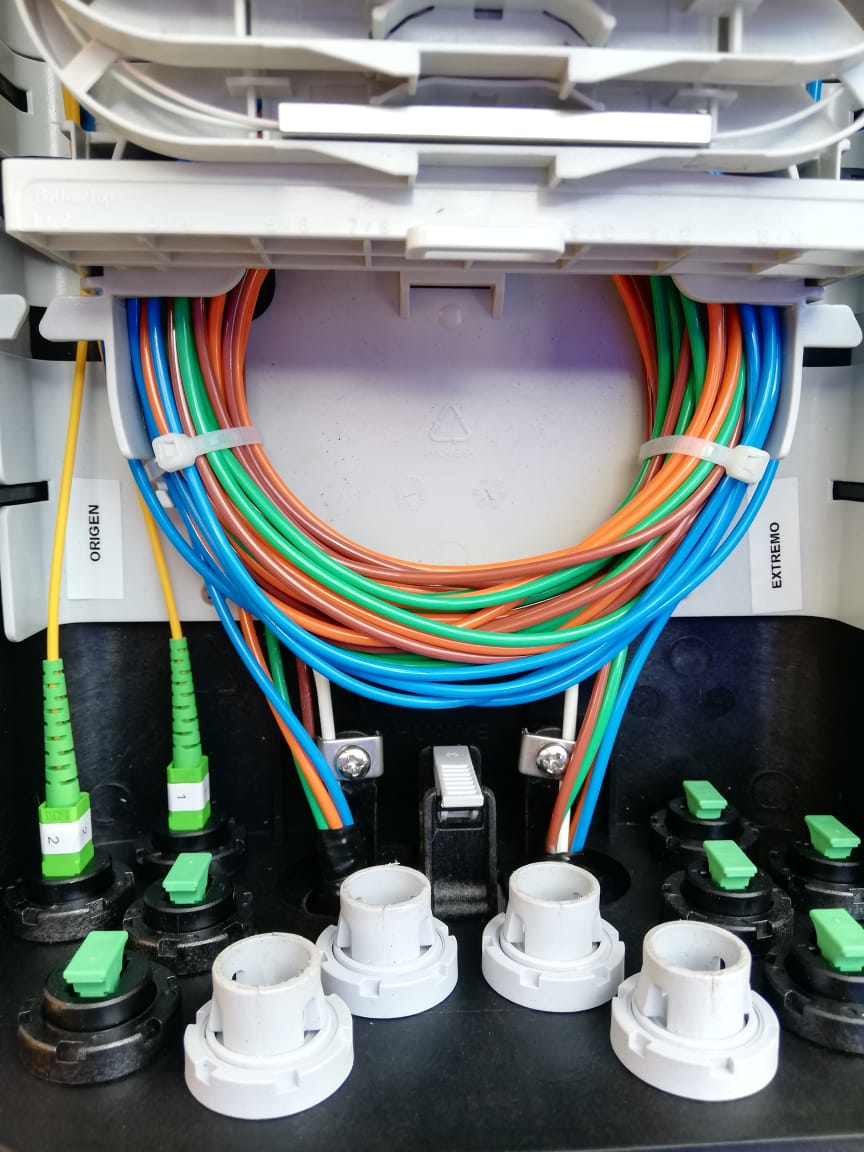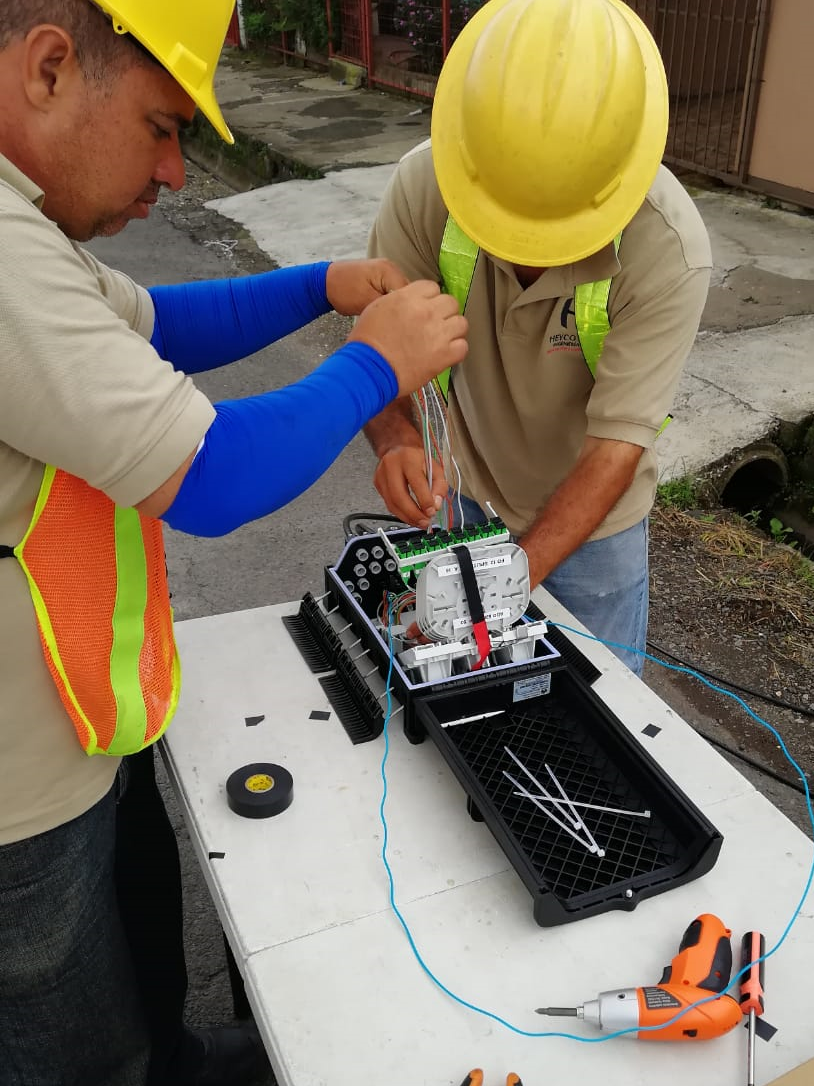Latin America continues to be a prolific market with very real possibilities of expansion for FTTH deployment. The pandemic has caused several challenges for the industry – financial, personal and service – but in Latin America it has also increased awareness of how vital it is to offer faster, more capable communication services to maintain the higher connectivity now demanded. Service providers and governments are finding new ways to support the growth of FTTH networks.
Edna Preuss, director, industry affairs and member services at the Fiber Broadband Association’s LatAm Chapter, explained: ‘The demand for bandwidth already seen in past years continues to increase, and, more than ever, operators and governments in the region are invested to improve services of fibre optic networks.
‘This is especially the case for those players with extensive copper networks which, in recent years, have been migrating to offer fibre optic services to their customers.’ An example of this commitment, said Preuss, is Costa Rican Electricity Institute (ICE). The service provider joined the chapter 10 years ago to learn about FTTH network deployments, and today it provides 80 per cent of FTTH installation in the country.
Fibre future
More than two years ago, the company decided not to invest in copper anymore. All new developments and investments would be towards fibre, with the understanding that fibre is the future-proof technology. According to Roberto Sanchez Pacheco, responsible for project planning and execution technology networks and services: ‘ICE is currently developing four major projects to connect urban and rural communities in the short and medium term, including a project – on which they won a public bid – to connect 5,500 education centres.’

Recent data from the Organisation for Economic Co-operation and Development (OECD) indicates that from June 2019 to June 2020, Costa Rica enjoyed the third largest rise (62.2 per cent) in fibre optic network deployment, only behind Israel (99.8 per cent) and the United Kingdom (69.3 per cent). Fibre deployments in Chile grew by 37.6 per cent, ranking sixth on the list. Furthermore, the growth of connections is higher than the average for OECD countries, which reached 13.5 per cent in the period.
According to the OECD report, the proportion of optics in Chile grew by 7.64 percentage points, reaching a market share of 32.8 per cent, which is only surpassed by France (7.85 points) and New Zealand (8.57 points). With this, the proportion of fixed internet access with FTTH has doubled in the last two years.
Chile’s minister of transport and telecoms, Gloria Hutt, pointed out: ‘The increase in the deployment of high-speed networks is good news in different areas. Socially, it allows our users to access better quality connections, positively impacting their quality of life and allowing them to access more and better content. But it is also good news in terms of competition since, as this technology becomes widespread, it encourages companies to deliver better plans with better conditions for different users, and at more convenient prices.’
Pamela Gidi, the country’s telecoms undersecretary, added: ‘We are working quickly and without pause to improve Chile’s connectivity and reduce the digital divide.
‘We are deploying kilometres of fibre optics with projects such as Fiber Optic Nacional and Austral Fiber Optic; with important subsidies from the state, in addition to last-mile projects. These new digital tracings will allow thousands of citizens to access new technological features, such as video conferences, online education and telemedicine.’
Significant growth
New market research for the LatAm Chapter from IDate strongly indicates a growth in FTTH connections across the region. Preuss said: ‘As of last year, Latin America had about 54.5 million homes passed with FTTH/B networks and around 19.4 million connected users. This represents an 11 per cent growth in homes passed and 27 per cent in the number of users, with a take-up rate of 35.7 per cent compared to the end of the previous year.’

The study involved 18 countries* in the Latin America region. The market sees strong efforts in Brazil and Argentina with long extensions of territory, to expand fibre networks in nondense areas. ‘A very important part of this growth process,’ said Preuss, ‘is the work of small ISPs in the region.’
Preuss said that agreements between operators and acquisitions of existing infrastructure are also shaping a new order in the LatAm telecom market, which promises to impact the expansion of services.
‘Especially in Brazil and Argentina,’ she said, ‘operators have begun movements to find partners to strengthen the deployment of fibre optics by sharing infrastructures or creating alliances with financial companies or business partners.’
Leading this movement are American Tower, Phoenix Tower and Ufinet. Javier Valdez, consultant for several Argentinean service providers, such as TV Fuego and UshuaiaVision, highlighted that ‘infrastructure sharing cannot be viable if we don’t all use the same service. The technology has to be unified, and the best option is fibre.’
Step-by-step
Another important, much-needed step is regulation to guide and support these services. ‘We are going to start sharing the infrastructures, but we still need to regularise it – create a local, regional or universal regulation so that we all have a solid point,’ said Valdez. The region is working on this. Enacom, Argentina’s communications and media regulator, is om the path towards a regulatory plan. Another model, being tested by Telefónica in Brazil, is franchising the deployment of fibre optics, with a greater presence in small towns the aim.
This year Telefónica reached an agreement with investment group Caisse de dépôt et placement du Québec (CDPQ), to develop an independent wholesale network in Brazil. The deal means Telefónica and CDPQ each has 50 per cent of new company FiBrasil, in a cocontrol governance model. Telefónica’s stake will be held through Telefônica Brasil (Vivo) and Telefónica Infra, its infrastructure arm, with each holding a 25 per cent stake.
Acting as a neutral wholesale company, FiBrasil will deploy and operate fibre networks in medium-sized cities outside the state of São Paulo, and to market FTTH access to all telecommunications providers.
The new company starts with a portfolio of 1.6 million homes passed (HPs) from Telefônica Brasil, and intends to expand the network to 5.5 million homes in four years. CDPQ is investing up to $3.25m in the joint venture.
Telefónica COO, Ángel Vilá, said: ‘We are very excited about this opportunity to partner with CDPQ, with whom we share the ambition to accelerate fibre deployment in Brazil, contributing to growth plans of Vivo and for the digital development of the country.’ Christian Gebara, CEO at Telefônica Brasil added: ‘Vivo will be FiBrasil’s main customer, consolidating itself as the largest convergent operator in the country. The transaction is within our strategic pillars, allowing Vivo to improve its time to market and, at the same time, to have an even more efficient use of financial resources.’
Open access
Similarly in Chile, investment firm KKR recently entered into a $1bn agreement with Telefónica to create an open access wholesale company. KKR has acquired a majority (60 per cent) stake in Telefónica Chile’s existing fibre optic network, and will make it open access through the new independent company.
Upon approval, its business plan aims to expand broadband coverage in Chile from the current 2 million to at least 3.5 million households by 2023, providing wholesale service to more than 40,000 businesses, telecom towers and small cells.
The network will also provide access to under-served areas, with more than two-thirds of households covered away from high-income urban areas.
The new firm will be controlled by KKR. Waldemar Szlezak, infrastucture managing drirector for KKR, said: ‘We are excited to be working with Telefónica to create the first-ever open access wholesale fibre network in Chile. This will create competition where none exists today, helping Chilean families, companies and the economy recover and grow in the digital economy.’
Alfonso Gómez Palacio, CEO Telefónica HispAm, added: ‘This transaction demonstrates the value of our infrastructure and our willingness to contribute to the sustainable development of the fibre market in Chile.
‘We have seen increased commercial activity over the last 12 months, and this transaction will further support this momentum, as we will be able to accelerate the fibre-optic deployment. Our stake in the new company provides us with substantial flexibility in the long-term, in a market with enormous future potential. We are proud to share this project with our partners at KKR, a company with whom we have worked on key initiatives for Telefónica.’
A rise in startups
Bogotá, Colombia, was announced as the first city in the market to benefit from a neutral fibre network in the wholesale telecoms market. The news came as incumbent operator ETB and neutral infrastructure operator Ufinet signed an agreement to create a separate firm to commercialise a neutral FTTH network in the wholesale telecoms market in the city and nearby towns.
The network began by offering coverage to more than 1.2 million homes, but the initial plan aims to double that figure, offering coverage in the Bogotá region of about 2.5 million homes within three years. The strategy, said Ufinet, will allow more families to have ultra-broadband access, including layers 1 and 2. This is especially important in a pandemic world, when lack of connectivity or low speeds mean few opportunities to study, work from home, or enjoy entertainment.
These are all great efforts, enthused Preuss, to explore the Latin American market potential and increase the FTTH deployment in the region. ‘There is still tremendous growth potential in countries such as Argentina, Brazil, Chile, Ecuador and Colombia,’ she added. Providers in Latin America are always looking for ways to increase services’ capability using current installations.
ICE engineer Dennis Ulloa Ruiz, said their project agenda includes just that. ‘Our existing cables are 288 and below – which is already falling short.
‘We are starting a technological change looking for micro-fibre and micro ducts for a better use of the existing infrastructure (ducts) and to provide solutions of higher capacity.’

The challenges
Economic investments and incentives are challenges fibre optic network deployment, explained Preuss.
The most recent market study released by the LatAm Chapter identified five issues that are delaying the adoption of FTTH in Latin America: lack of strong ROI plans; mixed architectures with G.Fast or Docsis 3.1; inefficient public financing initiatives for deployment of FTTH; substitution by fixedwireless access or ‘hybrid’ access in remote or difficult to service areas, and consumer concern about service price, rather than quality.
However, Covid-19 and its associated remote work and connectivity needs have impacted the last issue.
Roberto Falconí, national director of technology at PuntoNet Ecuador, has seen this first-hand. ‘Many companies have taken the initiative that employees, when moving to work from home, would have much more robust internet services.
‘For us, specifically as FTTH providers, 2021 has been quite a positive year. During the whole pandemic process, we started installing about 2,500 links per month.’ Falconí reported a 185 per cent rise in bandwidth for homes and a PuntoNet goal to connect 60,000 houses this year – a significant increase from 35,000 in 2020.
Concluded Preuss: ‘The LatAm region could still benefit from government regulations and financial incentives from both public and private sectors, but the Covid-19 crisis changed the perception of broadband importance among consumers and providers. Network operators are eager to increase their reach with the announcement of several plans to expand services for a future of full fibre.’
*LatAm-18: Argentina, Bahamas, Barbados, Bolivia, Brazil, Chile, Colombia, Costa Rica, Ecuador, Guatemala, Jamaica, Mexico, Panama, Paraguay, Peru, Puerto Rico, Trinidad and Tobago, Uruguay.

While the pandemic has thrown financial, personal and service uncertainty across the globe, those on the frontline across the Americas carrying out deployments have their own and unique day-to-day challenges.
As a vendor of test, measurement and assurance solutions, as well as advanced precision optical solutions to customers throughout the world for almost a century, VIAVI Solutions is ideally placed to track the trends of each individual market, when it comes to deployment, and provide help to overcome some of their bespoke challenges.
In Latin America, one such trend is the adoption of a slightly different type of architecture for PON networks. Douglas Clague, solutions marketing manager, fibre optic field test, at VIAVI Solutions, explained: ‘We noticed that the Latin America market started using what they call “unbalanced splitters.” So, rather than the traditional balanced, splitter architectures, where light power going into one of these devices is then evenly divided among the output ports, the light going into an unbalanced splitter is divided unevenly, for example one output port gets 90 per cent of the light level, and the other one has 10 per cent, the next splitter 80/20, then 70/30 and so on along the splitter cascade.’
Some of the drivers for increasing adoption of this architecture in Latin America, reasoned Clague, include reach and also efficiency of time spent on site. He explained: ‘The networks can cover a larger or longer geographical distance, or, for example, if it’s an urban area they’re working in, then it allows networks to snake around larger square mileage.
‘These unbalanced splitter devices also tend to be connectorised. So rather than just having fibre tails with no actual connector, which would necessitate splicing work, by installing these unbalanced splitters, building the network can be more “plug-and-play”.’
Labour saving
By negating the labour-intensive splicing work in this way, fibre can be deployed more cost-effectively, and finding people with the skill level required for splicing is no longer a concern. Another benefit is that, due to the modular nature of this architecture, networks can be rolled out according to demand, being partially built and then extended/completed when required.
The challenge with this type of architecture arrives when it comes to build certification and sign-off, as Clague explained: ‘These unbalanced splitters look a little different on an optical time-domain reflectometer (OTDR) trace. That means that the standard algorithms in some of the OTDR test applications quite often can’t identify those unbalanced splitters correctly. That can make things very difficult for project managers or build managers to say, for certain, that the network has been built correctly.’
VIAVI spotted this trend and the associated challenge some time ago. It has since been providing assistance in the region, having adapted the algorithms in its existing equipment to be able to correctly recognise these unbalanced splitters and clearly determine the split ratio, and whether it is passing the loss requirements for that type of unbalanced splitter.
‘We added support for the unbalanced splitter network architectures to all of our OTDRs,’ revealed Clague. ‘And that was specifically done because we saw what was going on with these architectures deployed in Latin America.’
Interestingly, said Clague, this kind of architecture is now making its way into North America, thanks largely to the governmentbacked Rural Digital Opportunity Fund. ‘The first round, where service providers are able to apply for this funding, has now happened and the funds have been allocated,’ explained Clague. ‘It’s a mixture of utilities and service providers, including cable TV companies and traditional telcos, winning the funding and then having to look at actually building the networks, or extending their own networks into these rural areas.
‘A good number of these providers are opting for PON and they’re leaning more towards these unbalanced splitter architectures, simply because of the aforementioned reach benefits (but also cost benefits). Again, we’re in a strong position to help there because we’ve already equipped our OTDR to be able to do the tests and certifications.’
Future-proof
This has allowed the new networks to be built correctly and to the right standard and quality level to avoid problems and additional maintenance in the future.
Some other operators in North America have not been quite so fortunate, due to another trend that has emerged. Clague elaborated: ‘Building networks is one thing. The other part is hooking-up the customers, and how contractors or installers are performing at that – it’s actually a universal problem. We’ve seen some pretty interesting figures from a number of tier one operators about the rate of first-time installation failures.
‘It means that on that first visit, the installer or contractor can’t activate the service, and they have to leave the site before the customer is actually online. The average seems to be around 20 to 30 per cent, but we’ve seen some rather extreme cases where it’s been as high as 40, or even 50 per cent.’
This, of course, has the knock-on effect of an install being escalated and that a second truck roll has to occur. Maybe a more skilled network technician needs to be brought on board, before a customer can access the network, causing delays to service.
Clague offered an example: ‘There was one North American tier one operator for whom the scenario was that the installers were not equipped with the right kind of test equipment, which led to incorrect fault diagnosis or ‘blind’ fault finding. They were given basic tools like a broadband power metre and visual fault locator, and that was basically it. They found that there was no light on the drop fibre that was run into the home – the power measurement reading they took showed nothing.’
What to do?
The installer had to try to figure out what to do to get the service up and running. They tried using the visual fault locator, the assumption being no light means a fibre break, but still found nothing. By which point, of course, they had exhausted the capability of the tools available to them and the job had to be escalated.
‘It took six weeks for the repair crew to be co-ordinated and then come out and test the drop fibre. They tested the fibre and found that there was no break or problem whatsoever!’ As it turned out, the drop fibre had not been correctly connected to the splitter in one of the new nearby cabinets. The crew connected it up and their job was done. ‘A second installer then had to be organised to get the service turned up,’ explained Clague, ‘and that took another two weeks. And of course, it’s the third truck roll now.
‘So it’s taken two installers, one repair crew, three truck rolls, and almost two months to get service turned up. If the installer at the very beginning had something like our Optimeter product, it would have given them all the information to know exactly where any fault was and to determine if it is their responsibility to fix and to do that while they are still on-site or escalate it correctly.’


